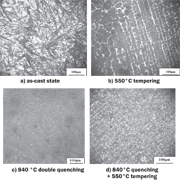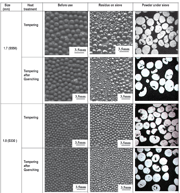Abstract: The effect of size from 2.0 mm to 0.85 mm on the Ervin cycle life of the high carbon cast steel shot was analyzed. Under different heat treatment conditions, high carbon cast steel shot were tempered at 550°C from both the as-cast state and 840°C double quenching. The results show that as the shot size decreased, the Ervin cycle life was basically prolonged, furthermore the high carbon cast steel shot tempered after double quenching has a longer Ervin cycle life than that of the shot tempered directly from the as-cast state.
Keywords: high carbon cast steel shot; tempering; double quenching; size; Ervin cycle life
1. Introduction
Ervin cycle life tested by the Ervin testing machine can represent the wear resistance of the metal abrasive[1,2], and directly depends on atomization method, metal abrasive component and microstructure[3,4,5]. Under the same conditions, the further effect of size on Ervin cycle life was studied in this paper. In this comparative study, two heat treatments were chosen, i.e. 550°C tempering from the as-cast state and 550°C tempering again after 840°C double quenching. Meanwhile, in order to mimic the continuous heat treatments in regular production, 30 minutes was chosen as the preserving time. In order to improve performance price ratio of the high carbon cast steel shot during the regular production, high carbon cast steel shot only undergoing a directly tempering heat treatment from the as-cast state can reach the required hardness according to ISO11124-3[1] and SAE J827[2] standards as well as the application requirement of users; to improve service performance of the high carbon cast steel shot, double quenching was needed to eliminate the dendrite composition segregation formed by the rapid solidification during the centrifugal atomizing process. 840 °C was chosen as the quenching temperature, it could make high carbon cast steel shot heated into the austenite region, eliminating the dendrite composition segregation and improving structure.
2. Materials and methods
The as-cast high carbon cast steel shot sample in this experiment was manufactured by Shandong Kaitai Metal Abrasive Co., Ltd, as shown in Table 1, and melted by using intermediate frequency induction furnace and formed by centrifugal atomizing method. The samples with grain size of 0.85 mm -2.0 mm are in good spherical shape with least amount of irregular particles. A box resistor stove is used as the heating device and water is used as the cooling medium. The processed samples are etched by the alcohol solution with 3% of nitric acid and then studied for microstructures with a metalloscope. The micro-hardness of the processed samples are tested by using the vickers hardness tester with a 500g load. The Ervin cycle life is tested through using an Ervin testing machine according to 100% replacement method, and the sample is screened through a sieve with a 0.425mm diameter mesh[1,2].
3. Result and Analysis
3.1 Microstructure and Microhardness
As shown in Figure 1 a), the microstructure of the as-cast high carbon cast steel shot is the high carbon lenticular martensite and the retained austenite. Due to the micro-cracks caused by the impact of the brittle martensite plate[6,7] which could be developed into macro-cracks, and the serious composition segregation because of the rapid solidification during the centrifugal atomizing process, this kind of high carbon cast steel shot has a short Ervin cycle life. If the as-cast high carbon steel shot is directly tempered, the carbide segregates at the boundaries of the dendritic austenite and the composition segregation is hardly eliminated.
See Figure 1 b), when the as-cast sample is tempered at 550°C and preserved for 30 minutes, the microstructure is tempered troostite and network carbide and the hardness is HRC41.5; the shot is easy to break up along the high carbon network carbide and has a short life span.
After the sample is double quenched at 840°C for 30 minutes, the microstructure is transformed to fine cryptocrystalline martensite with little retained austenite and some unsolvable granular carbides, see Figure 1 c). The composition segregation is improved while the hardness increases to HV 803.8 (HRC 63.1). Figure 1 d) shows that by tempering at 550°C after 840°C double quenching, the cryptocrystalline martensite and the retained austenite go through a decomposition process and transform into carbides and ferrite, namely the microstructure is tempered troostite [7,8] and the structure uniformity is improved, the hardness is HRC45.
3.2 Relationship between Ervin cycle life and heat treatment conditions, size
From the two rising Ervin life curves in Figure 2, between the size of 2.0 mm and 0.85 mm, when the size decreases, the Ervin cycle life increases gradually. In the blast cleaning process, each shot is provided with a certain amount of kinetic energy, i.e. impact energy, and the abrasive depends on the impact energy to implement the cleaning or peening process on the workpieces, where the impact energy is 1/2mv2, m and v represent the mass and velocity of the shot respectively, so the impact energy is proportional to the mass of the shot. In the Ervin test, the shot is impacted to the target (Hardness > HRC63) at an impact velocity of about 61 m/s, but the hard target isn’t deformed (in the regular blast cleaning process, the workpiece is much softer and obviously deformed absorbing part of impact energy) so that the impact energy of the shot partly converts to rebounding kinetic energy of the shot and the heat energy of both the shot and the target and another part is absorbed by the shot itself[9], generating the deformation, abrasion and fracture. The shot in larger size has a larger mass as well as a larger impact energy[10,11] and gets a larger force, so the larger shot is much easier to be fractured than the little one and has a shorter Ervin cycle life. In addition, compared with the larger shot, the shot in small size is much easy to eliminate the gas or inclusion during the solidification and easily get an uniform structure during the heat treatment process, then the little shot contains a little amount of the defect, such as the crack and porosity, and the proportion of the little shots containing defects is lower, therefore the small shot gets a larger density[12]. All these aspects can improve the Ervin cycle life.
Furthermore compared with the tempering from the as-cast state, tempering again after double quenching can notably improve the Ervin cycle life of the high carbon cast steel shot, see Figure 2, the Ervin cycle life can increase 33 percent to 37 percent, namely the Ervin cycle life increases from 2629 cycles - 2942 cycles to 3502 cycles - 3919 cycles. This is because heat treatment of tempering again after double quenching could eliminate the composition segregation and improve the structure uniformity, and the microstructure is ferrite and dispersive distributed carbides, improving the impact toughness as well as homogeneous deformation and decreasing the wear rate.
Taking the samples in size of 1.7 mm and 1.0 mm, the wear morphology change of the high carbon cast steel shot is observed during the test of Ervin cycle life according to 100% replacement method, see Fig.3. Except newly added shots and some cycled shots are worn into spherical shape with many little facets[11], the residue of the sample tempered from the as-cast state are mostly hemisphere debris, while the residue of the sample tempered after double-quenching are basically in core spall; it shows that the shot tempered after double-quenching is in ductile fracture, but the shot tempered from the as-cast state is in brittle fracture because of the carbide segregation at the boundaries of the dendritic austenite. In addition, magnifying the powder under sieve, it shows that the powders are in arbitrary shape,such as sphere with many facets, hemisphere, core spall and multiangular shape, where the powder of the sample tempered from the as-cast state are mostly hemisphere and multiangular shape, and the powder of the sample tempered after double-quenching are dominantly sphere with many facets and core spall.
4. Conclusion
The microstructure of the as-cast high carbon cast steel shot is high carbon lenticular martensite and retained austenite; after tempering directly at 550°C for 30 minutes from the as-cast state, the mircostructure is the tempered troostite and network carbide segregating at the boundaries of the dendritic austenite; after double quenching at 840°C for 30 minutes, the composition segregation is improved and the structure transforms into fine cryptocrystalline martensite with little retained austenite and some unsolvable granular carbides, further tempering at 550°C for 30 minutes, the microstructure is carbides and ferrite, namely the tempered troostite.
Between the size of 2.0 mm and 0.85 mm, the Ervin cycle life will increase as the increase of the shot size. Comparing with the tempering heat treatment directly from the as cast state, the tempering after double quenching can more obviously improve the Ervin cycle life, in which the Ervin cycle life increases up to 33%~37%, from 2629~2942 cycles to 3502~3919 cycles.
5. References
1. Ervin Industries. 2002, The Ervin Test Machine.
2. SAE J445 January 1996, Metallic Shot And Girt Mechanical Testing.
3. SAE J827.1996, High-Carbon Cast-Steel Shot.
4. ISO11124-3.1993, Preparation of steel substrates before application of paints and related productions –Specifications for metallic blast – cleaning abrasives - Part 3: High-Carbon Cast-Steel Shot and Grit.
5. Franc Zupanic, Influence of atomizing conditions on the properties of a high carbon cast steel shot, KZLTET 33(5)361(1999).
6. Zuyao Xu, Martensitic transformation and martensite, RPC, Beijing (1980), p.178-190.
7. R W K Honeycombe, 1981, “Steels Microstructure and Properties”. London: Edward Arnold Ltd, 140-165 8. Zhengfeng Qi, Heat treatment principles for metals, RPC, Beijing (1988), p.155-171.
9. Ruwei Liu, Analysis of several questions associated with abrasive for shot blast cleaning of castings, Foundry, No.5 (1996), p.23-26.
10. Qinglin Yang, Binghuan Wu, Yongan Liu. The Influence of Abrasive Size on shot blasting Efficiency and Casting Surface Roughness.China Foundry Machinery and Technology, 2002/6, p.10-13.
11. George A.Calboreanu.The Target Hardness Influence On Impact Damage Shot.The American Society of Mechanical Engineers, 1991, p.101-110 (Reprinted From Wear of Materials, 1991)
12. Xipeng Jiang.Preproduction of steel shot using gas spurt.Foundry Machinery, 1983, No6, p.10-14.
13. Ruwei Liu, Comparative analysis of abrasive for shot blasting steel structure, steel construction (2004),Vol.19, No.71, p.70-71.
14. A.Hatano and K.Namiki, Daido Steel Co., Ltd. 1990.5, Development Of Hard And Tough Steel Shot. ICSP-4, 37-46
For Information:
Authors:
Xinhua Zhao (1), Ruwei Liu (1), Hongwei Wang (2), Hongju Gao (1), Laibin Zhang (3), Chengmin Wu (3), Ruiguo Wang (3)
1. Material Science and Engineering College of Shandong University, Jinan 250061, P.R.China,
2. Chemical Products Recovery Workshop, Laiwu Steel Co.,Ltd, Laiwu 271104, P.R.China
3. Shandong Kaitai Metal Abrasive Co., Ltd, Zouping 256217, P.R.China
Tel. contact of Ruwei Liu: +86.13616407190
E-mail: liuruwei@sdu.edu.cn
































